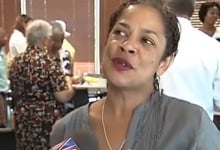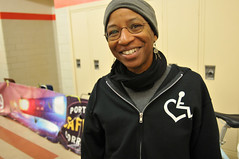
speaking with KATU news last night.
(Image: Still from video below)
Since the meeting last week where racism and gentrification were the main topics of discussion, there have been some developments around the City’s North Williams Traffic Safety Operations project.
The official Stakeholder Advisory Committee (SAC) met last night at Legacy Emanuel Hospital last night for the sixth time. Described as a “regroup” meeting by one of the SAC members, one big thing on the agenda was the addition of nine new people to sit on the committee. I’m still waiting for the complete list from PBOT* (I wasn’t able to be there), but according to coverage of the meeting by KATU-TV, not surprisingly, “most of the new members are African-American.”
One of the new members is Michelle DePass, whom you might recall is the woman who can be credited with putting the racism issue front and center at a meeting back on July 20th.
As for KATU, they did a respectable job covering the story (despite the “Bike Lane Fight” title and making it seem like the issue is between enhancing the bikeway and “reducing traffic”). Watch the video that aired last night:
Another thing that came up at the meeting, was a new proposal shared by Carla Danley. Danley is on PBOT’s Bicycle Advisory Committee (the citywide committee, not to be confused with the committee for this specific project). She proposed removing the bikeway on Williams altogether and instead making N. Rodney (a through street to the east) a carfree street for bikes only.
Danley shared the idea with me via email. One of Danley’s concerns is that a physically separated bikeway (which is on the table for Williams) impedes access for those in wheelchairs. She feels that a carfree Rodney is a better solution for that and many other reasons including:
– the interested-but-concerned riders get a major thoroughfare free of cars
– a car-free street is a cleaner, healthier, more pleasant ride than inhaling bus/auto fumes on N. Williams (and should be marketed that way to cyclists)
– in the absence of cars, the street can absorb higher bike traffic
– removing the bikes from Williams eliminates the bike-on-bus conflict
– N. Williams functions as an arterial instead of a collector because the need must be there or people would travel MLK or the I-5 were they really meeting the need
– the cycling community already has a rep for being bad citizens. This is an opportunity for cyclists to show leadership in the city by really listening to long-time residents of the neighborhood and responding by coming up with a win-win
Danley envisions Rodney as a two-way bikeway in the center of the street with motor vehicle access for permitted residents only and with no on-street parking.
“Ultimately, as Portland struggles to move bikes, cars and freight at ever higher volume with the same size streets the only viable solution will be car-free and bike-free streets (we may even develop some ‘freight only’ corridors, similar to HOV lanes in other cities),” writes Danley.
The Rodney alternative is just an idea by one citizen; but it shows that along with adding new voices into the process, PBOT is also opening the discussion up to new engineering solutions as well.
One last update on this project. The City of Portland has is still planning a larger event to discuss “how transportation planning and the condition of our street relates to history, racial and economic injustice and gentrification.” That event is planned for sometime in September.
Writing about the event in a project outreach update, PBOT wrote:
“We have an opportunity in the North Williams project to model inclusive planning that takes account of past planning mistakes. However, the Project Team has more to learn from community members about how this project could affect them and how they want to be involved; community members also have much to learn from one another about these effects.”
— Stay tuned for more Williams project coverage and read archived coverage here.
*UPDATE: Here is the list of new members added to the SAC yesterday (bringing the total number to 27):
-
Tom Anctil – Anctil Heating & Cooling
Noni Causey – Education specialist, small business owner
Michelle DePass – Neighbor
Kenneth Doswell – Betty Jean Couture
Gahlena Easterly – Neighbor
Matt Hennessee – Vancouver Avenue First Baptist Church
Jazzmin Reece – Urban League Young Professionals
Dwight Terry – Terry Family Funeral Home
Mychal Tetteh – Village Market at New Columbia



